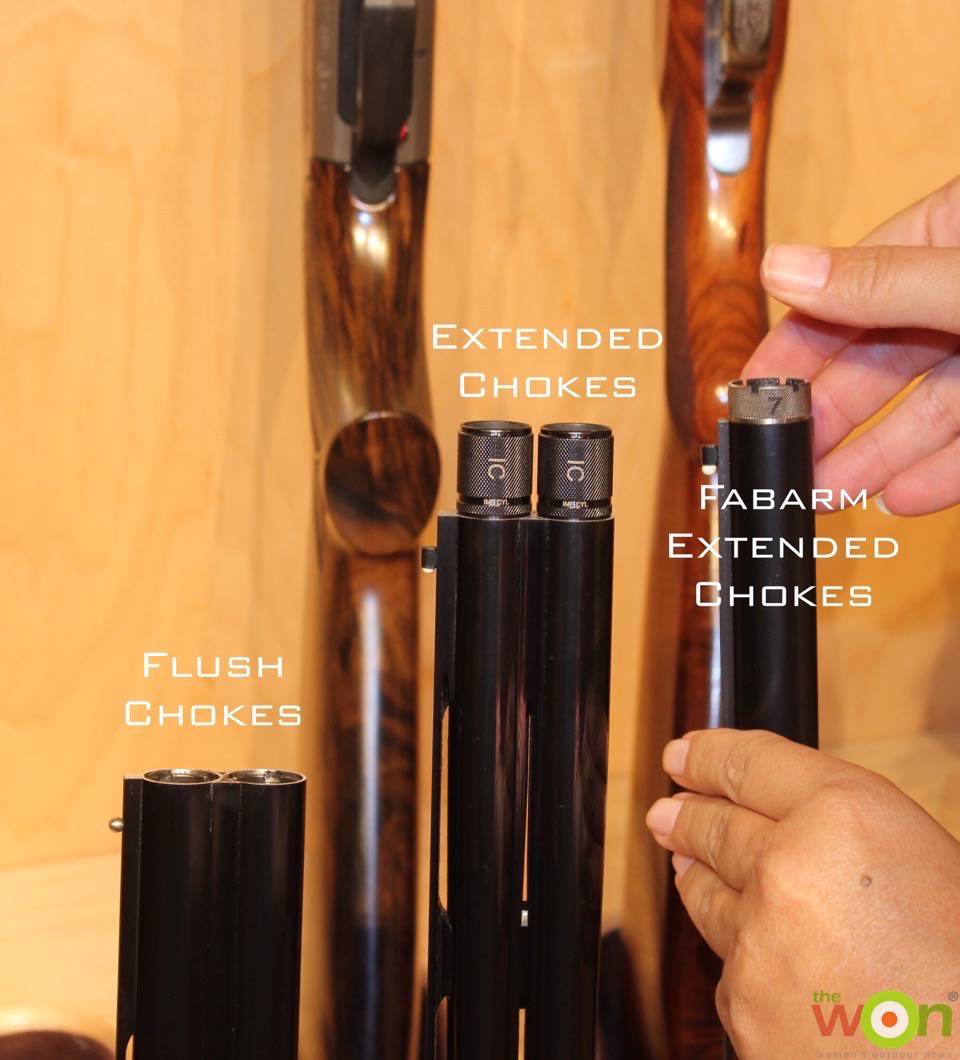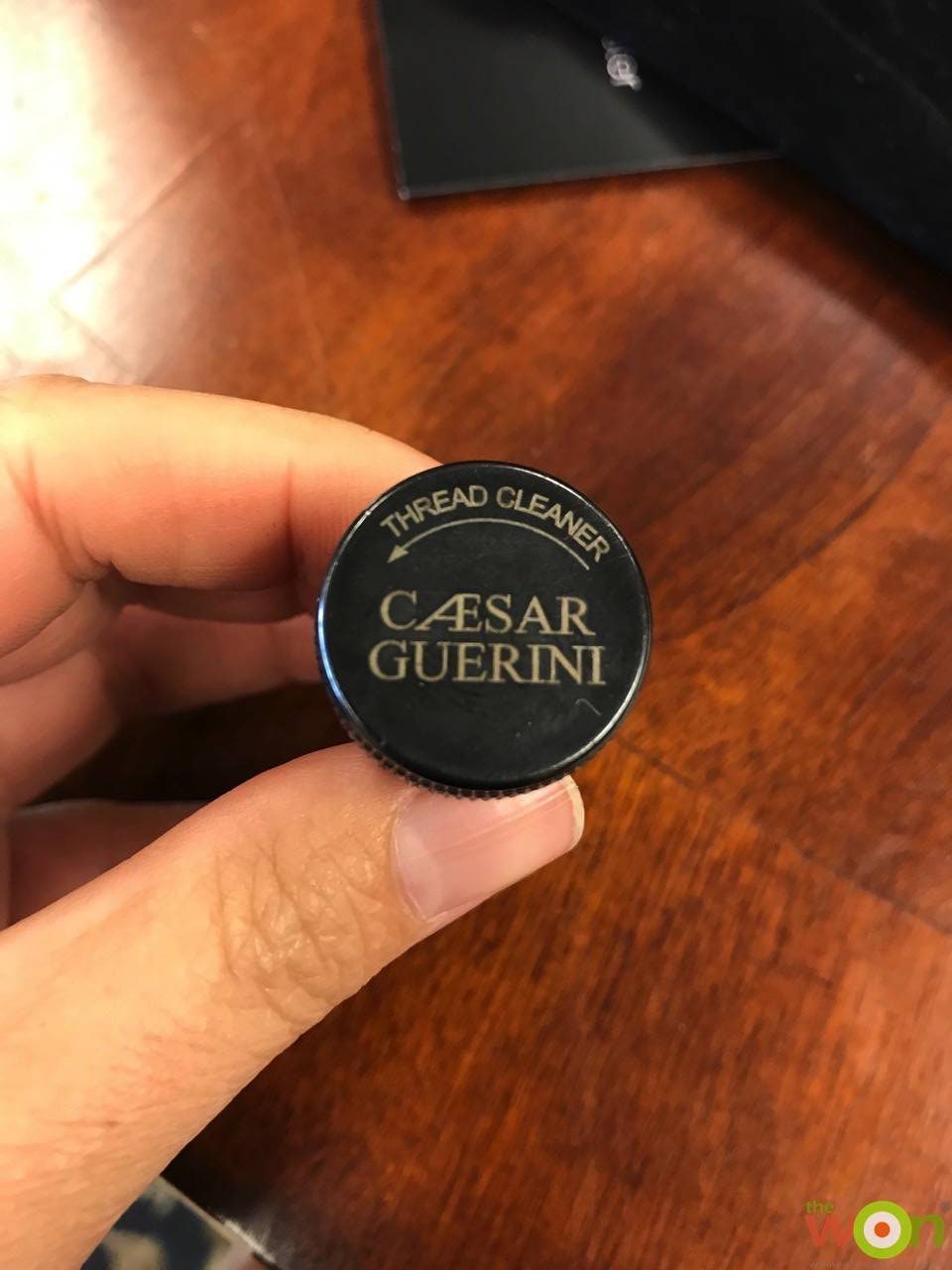This isn’t an uber-technical column where I go through choke constrictions by the millimeter and tell you thread sizes for front beads. It’s a more an overview of what chokes you need so that you’re comfortable with what you have in your gun. Along the way I’ll cover some basics on what the beads are for on the front of your shotgun.

Elaina McCarthy shooting Light Full Chokes at the Grand American
The game of skeet requires a more open pattern of shot, because the targets are close and you have a standard set of shots (the same on every skeet field)—hence the name of that choke constriction. Trap is similar, in that there are only 5 trajectories for the targets, but it requires the opposite constriction. Most trap shooters use Modified, Improved Modified and Full chokes to keep their patterns tighter for longer distances, especially when they move back toward the 27-yard line. The biggest variable in the clays game is sporting clays, because the targets are everything from close-up shots at 15 yards to 60-yard crossing birds…and those two may be on the same station!
If you ask 100 people which chokes they use and why, you’ll probably get 100 different opinions. The key is to try out different constrictions and figure out the ones you feel comfortable with and give you confidence that you’ll hit the bird.

In my capacity as brand manager at Syren, I got a call from a trap shooter the other day who wanted to know which choke patterned better at the 20-yard line—the Modified or the Improved Modified, with a shell that fired at 1,145 feet per second (fps). He wanted an exact answer right then on the phone, because he was shooting in an hour. He got very frustrated because I told him I couldn’t tell him that (and I wouldn’t send him back to a gunsmith, because they couldn’t tell him the answer either). I suggested he use a pattern board to determine the best one. He was emphatic that he couldn’t do that, as the pattern board was only for 16 yards with a full choke. This is like someone calling you and asking how a 3-inch wedge-heeled, suede shoe would fit them…without them ever giving you the brand of shoe.
Every gun is different, and there are a multitude of shells on the market in 1,145 fps. For some tests, specifically “point of impact,” a bench rest is used at 40 yards, and shot with a full choke. But for his situation, there’s no reason why you can’t stand at 20 yards (or 25 or 30 or 40) and do the same thing with the desired chokes to see how they pattern with the chosen shells. If you are going to do this, be sure to use a big piece of butcher paper so you can draw a circle around your shot pattern after each shot and compare each one. Use different colored markers to identify each grouping and differentiate each pattern…and bring extra paper. My point is that if you really want to know how different chokes pattern in your gun, there’s no simple answer—you really need to do the work to figure it out for your gun, and your shells, to find the choke that gives you the comfort level to hit targets at different distances.
In addition to the constrictions, there are also flush-style chokes, which are even with the end of the gun, and extended chokes, which extend beyond the end of the gun. There are also fixed-choke guns where the barrels are bored at a specific constriction and cannot be changed. These are good for people who either don’t like to change their chokes, or don’t need to. Caesar Guerini–sponsored shooter Richard Faulds, from England, shoots a fixed-choke gun.
Flush chokes are typically used for field guns where you are less likely to need to change them on the fly. Sporting clays has the most varied targets, so it usually causes the most angst as to what chokes to put in for each station; using extended chokes lets you remove and replace them fairly quickly, as often as you deem necessary.
All shotguns come with chokes from the manufacturer, but several after-market companies also make them. My advice is to pattern the factory chokes first before spending money on new ones. I know Caesar Guerini and Fabarm spend a lot of time patterning their chokes for their guns. Our trap guns come with 3 factory chokes, field guns come with 5, and sporting/competition guns come with 6. Once you pattern them, you will be able to compare them to any aftermarket chokes that you try in your gun.

Remember to clean your chokes regularly, and use adequate grease to ensure they don’t rust or get stuck (it happens more often than you think). Caesar Guerini also provides a choke wrench with its guns, as well as a choke thread cleaner, which can be used by just screwing off the top and twisting it into the threads. Briley makes a syringe of blue grease that is great for applying a thin line of grease before you screw your chokes back into your gun.

In addition to the chokes at the front of the barrel, there are also front beads. To bead or not to bead…that is the question. For pistol and rifle shooters, lining up the beads to shoot is required to get the bullet where you’re looking. But for shotgun, we don’t “aim” the gun, we “point” the gun. When you are mounting the gun for fit and to see where your eye lines up with the barrel, it’s very important to see how the bead(s) line up. If you have a mid-bead, they should look like a figure 8, with the front bead on the top. If there’s no mid-bead, the front bead is more of a reference point.
Once you’re out shooting clay targets or real birds, you’re not supposed to look at your gun, you’re supposed to look at the target. So at that point, you really don’t need a front bead.
Your eyes cannot focus on two things at two distances at once, so if they are looking at the end of your shotgun, they can’t focus on a target 30 yards away. If you start by looking at the target, and then are pulled back to look the barrel (by your fiber-optic bead), it drastically reduces your chances of hitting the target, since when you look at the gun, you slow down the movement of your barrel while the target is still moving forward.
An exception to this would be stationary targets—like turkeys, or 3-Gun matches where the clays are attached to a post. In those instances, lining up the bead helps with accuracy.
Pistol and rifle shooters usually (but not always) have a harder time adjusting to not looking at the gun. I’ve had Special Ops guys ask, “Where on the gun am I supposed to look?” They have a hard time not focusing on lining up those beads after years of practice and real-world use. I’ve found that people who play golf, tennis or softball pick up clay shooting more quickly as they have learned to “keep their eye on the ball.” The only difference between those sports and shooting is that the gun is right next to your face, rather than a club or bat or racquet, that’s out of view until swung.
I had a gentleman call and say that his friend had installed a fiber-optic glow-in-the-dark long red bead on the front of his gun; he thought it looked super cool, and he might want one on his gun too. So I asked him: “If the whole premise is to not look at the end of your gun when shooting clays, why would you want to put something there to pull your eyes back to it?” There’s a reason the cop pulls over the red car, rather than the gray one that was going faster. He thought about that for a moment and remembered that his friend had said he was having some trouble hitting targets as consistently as he had before the big red bead, and thought better of it…and was maybe going to share this news with his friend to see if that might help him improve his consistency.
In 2001, I purchased a Browning 525 Citori that had a green fiber-optic bead. I found it nearly impossible not to look at it when I was shooting, so I took it out. I left the mount there in case I needed a reference point (it’s the same color as the barrel), but whenever someone—usually a man—told me it was missing, I would counter with “I’m not supposed to be looking at the gun, anyway.” To which they always begrudgingly agreed.

Shooting a sporting gun with 2 beads.
There is a place for fiber-optic beads, even on our Fabarm guns, however—and that’s on the camouflage Waterfowler guns. I asked the gunsmiths why we had them there and they said that that’s what the customer wants. At this point, if you have one on the end of your gun, you can choose to keep it there or take it off.
I know I’ve presented a lot of information above, and plenty of choices regarding chokes and beads. It’s a lot to take in, but I think that when you have as much information as you can get about real-world clay and bird shooting, you can make an informed choice that’s right for you.
Lynne is on to her next adventure after over four years in Maryland with Caesar Guerini and Fabarm as the Brand Manager for Syren (a line of shotguns made for the ladies). She has attended dozens of demos and events and has been honored to get to meet and introduce hundreds of ladies and young girls (and lots of boys and men too) to all 3 brands and to shotgun shooting! Lynne has learned so much about shotguns – gun fit, eye dominance and mechanics – that shows her just how much more there is to learn. She now is doing marketing and branding consulting and also plans to stay active in the outdoor industry, do more hunting and sporting clays, shooting lessons and add some fly fishing to her repertoire. She’ll be based in the Dallas Fort Worth area. View all posts by Lynne Green
I starting to get into Sporting clay. I’m having a tough time deciding on a shotgun style. O/U, Pump or SA. Most of the photos in the articles I have read shown the shooter with an O/U. Is there a preferred shotgun to use in sporting clay. I have shot SA & pump action so far with a few O/U shots.